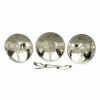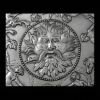 A shield for show and sacrifice?
A shield for show and sacrifice?
Iron Age, 350-50 BC
Found in the River Thames at Battersea Bridge, London, England
Length: 77.700 cm
The Battersea shield was not made for serious warfare. It is too short to provide sensible protection. The thin metal sheet and the complicated decoration would be easily destroyed if the shield was hit by a sword or spear. Instead, it was probably made for flamboyant display. The highly polished bronze and glinting red glass would have made for a great spectacle. It was finally thrown or placed in the River Thames, where many weapons were offered as sacrifices in the Bronze Age and Iron Age.

Iron Age shields are not commonly found. Those shields excavated from Iron Age burials were made of wood, sometimes covered with leather. They have very few metal parts. The Battersea shield is not in fact a complete shield, but only the facing, a metal cover that was attached to the front of wooden shield. It is made from different parts of sheet bronze, held together with bronze rivets and enclosed in a binding strip. All the rivets are hidden by overlaps between different components where the panels and roundels were originally attached to the organic backing.

All of the decoration is concentrated in the three roundels. A high domed boss in the middle of the central roundel is over where the handle was underneath. The La T�ne-style decoration is made using the repouss� technique, emphasized with engraving and stippling. The overall design is highlighted with twenty-seven framed studs of red enamel (opaque red glass) in four different sizes, the largest set at the centre of the boss.
I.M. Stead, The Battersea Shield (London, The British Museum Press, 1985)
S. James and V. Rigby, Britain and the Celtic Iron Ag (London, The British Museum Press, 1997)
R. Bradley, A passage of arms (Cambridge University Press, 1990)
The Thames:
Sacred river of the Celts
The river's name is Celtic and may mean ''the dark one". It was first recorded by Julius Caesar, who called it the "Tamesis", following his expedition to Britain in 55 BC. The Celts viewed the Thames as sacred, and made offerings of precious metalwork to the god of the waterway. Offerings discovered at low tide include shield bosses, from Wandsworth, a beautiful bronze shield from Battersea, and a horned helmet by Waterloo Bridge.








